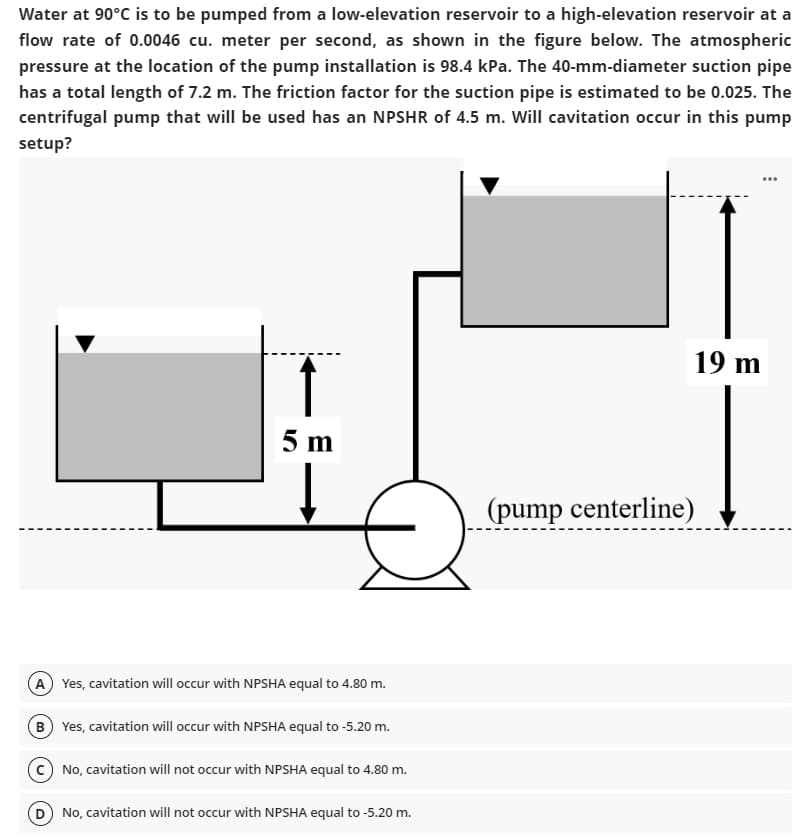Water at 90°C is to be pumped from a low-elevation reservoir to a high-elevation reservoir at flow rate of 0.0046 cu. meter per second, as shown in the figure below. The atmospheri pressure at the location of the pump installation is 98.4 kPa. The 40-mm-diameter suction pip has a total length of 7.2 m. The friction factor for the suction pipe is estimated to be 0.025. Th centrifugal pump that will be used has an NPSHR of 4.5 m. Will cavitation occur in this pum setup?
Water at 90°C is to be pumped from a low-elevation reservoir to a high-elevation reservoir at flow rate of 0.0046 cu. meter per second, as shown in the figure below. The atmospheri pressure at the location of the pump installation is 98.4 kPa. The 40-mm-diameter suction pip has a total length of 7.2 m. The friction factor for the suction pipe is estimated to be 0.025. Th centrifugal pump that will be used has an NPSHR of 4.5 m. Will cavitation occur in this pum setup?
Principles of Heat Transfer (Activate Learning with these NEW titles from Engineering!)
8th Edition
ISBN:9781305387102
Author:Kreith, Frank; Manglik, Raj M.
Publisher:Kreith, Frank; Manglik, Raj M.
Chapter5: Analysis Of Convection Heat Transfer
Section: Chapter Questions
Problem 5.37P
Related questions
Question

Transcribed Image Text:Water at 90°C is to be pumped from a low-elevation reservoir to a high-elevation reservoir at a
flow rate of 0.0046 cu. meter per second, as shown in the figure below. The atmospheric
pressure at the location of the pump installation is 98.4 kPa. The 40-mm-diameter suction pipe
has a total length of 7.2 m. The friction factor for the suction pipe is estimated to be 0.025. The
centrifugal pump that will be used has an NPSHR of 4.5 m. Will cavitation occur in this pump
setup?
5 m
↓
(A) Yes, cavitation will occur with NPSHA equal to 4.80 m.
B) Yes, cavitation will occur with NPSHA equal to -5.20 m.
No, cavitation will not occur with NPSHA equal to 4.80 m.
(D) No, cavitation will not occur with NPSHA equal to -5.20 m.
(pump centerline)
19 m

Transcribed Image Text:A 35-inch centrifugal pump with performance curve shown in "PUMP CURVE 2.0" is to be used to
transport 27,000 gpm of water from one reservoir to another reservoir. If the head loss in the
suction pipe is to be limited to 5 feet, what approximate distance in feet with respect to the
pump centerline (z = 0) should the distance of the reservoir free surface be? Assume water is at
78°F and standard atmospheric pressure at sea level at pump location.
Note: Elevations above the datum line are denoted as positive, while elevations below that
datum line are denoted as negative.
Round your answer to 2 decimal places.
Expert Solution
This question has been solved!
Explore an expertly crafted, step-by-step solution for a thorough understanding of key concepts.
Step by step
Solved in 3 steps

Knowledge Booster
Learn more about
Need a deep-dive on the concept behind this application? Look no further. Learn more about this topic, mechanical-engineering and related others by exploring similar questions and additional content below.Recommended textbooks for you

Principles of Heat Transfer (Activate Learning wi…
Mechanical Engineering
ISBN:
9781305387102
Author:
Kreith, Frank; Manglik, Raj M.
Publisher:
Cengage Learning

Principles of Heat Transfer (Activate Learning wi…
Mechanical Engineering
ISBN:
9781305387102
Author:
Kreith, Frank; Manglik, Raj M.
Publisher:
Cengage Learning